L'Italiano Navigando - Sailing trip
Piccola Università Italiana - The Italian language school by the sea
The "L'Italiano Navigando" can be booked as an extension to your Italian language courses in Tropea.
L'Italiano Navigando ...is a new kind of Italian language course for all those who love this language but also love our beautiful country and its sea.
On this course you can discover Italy's picturesque countryside and sail around the 7 Lipari islands on a boat with a length of 22 metres and delve into the life and language of Italy.
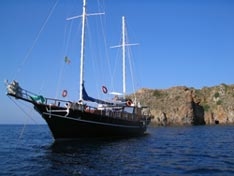
Luscious green surroundings accompanied by crystal clear deep blue seas create an extraorinary fascination and let you relax and find peace. The week is topped off with diversifeid and interesting trips on land on Stromboli and the other Lipari islands.
Accomodation is provided in double or single cabin.
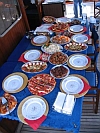


The galley provides excellent Italian cuisine.
The whole week is spent in close contact to the crew, which creates an excellent possibility to improve your knowledge of the Italian language and culture.
The programme is available in June and September!
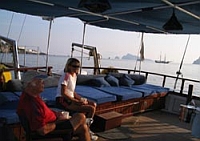
Embarkment is on Saturday at 5 pm in Tropea and we return to land the following Saturday at 9 am.
 The "L'Italiano Navigando" sailing boat
The "L'Italiano Navigando" sailing boat
• The cabins
The cabins are practically furnished with a wardrobe, chest of drawers and a bathroom with a shower with cold and warm water. There are 2 beds in the cabins but they can also be used as a single cabin.
• The main cabin
The main cabin has a fully equipped galley, TV VCR and DVD player, CD Player and a mobile phone charger.
• On deck
The upper deck has 10 places for sunbathing and an outside shower. At the rear of the boat is a dining table and some cosy sofas.
• The sailing trip
4 hours of sailing are planned for each day, nights are normally spent in the roads. Shore can be reached by motorised dinghy.
• The galley
The galley offers refined Mediterranean seafood specialities; the menu is mostly made up of fish dishes. Please inform us in advance of any special wishes regarding food (special diets or allergies)
• Cleaning
The crew is responsible for the daily cleaning of the cabins and the changing of linens.
The „L'Italiano Navigando" programme
„The Seven Sisters"
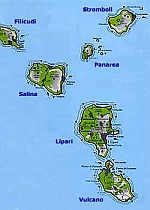 ...born of fire and water, rising steeply from the surge below, these towering rocky majesties, the Lipari Islands, uncloak the whole elementary force of nature....
...born of fire and water, rising steeply from the surge below, these towering rocky majesties, the Lipari Islands, uncloak the whole elementary force of nature....
The history of this archipelago, the birthplace of cultures, has been woven with myths and sagas since the time of the Sicels and the Greeks, the Phoenesians and the Etruscans,the Romans, the Normans, who are all still kept alive here, their presence continues to be felt and it entices restless travellers in search of destinations never to be found but reveals magical, scenic, certainly unique landscapes.
The seven islands are all of volcanic origin and offer the holiday the holiday ‚sailor‘ a broad spectrum of possibilites. From simple country life on Alicudi and Filicudi, the archipelago's oldest island which originates from about a million years ago to the exclusive scene of Panarea, from the lush vegetaion of Salina to the laid back culture of Lipari and to the breathtaking beauty of the (active) Stromboli volcano and the cliffs of Vulcano.The most Southern point of the group of islands is marked by the Vulcano lighthouse. This high, white tower stands above a 2 storey, white building on the shore of Punta die Porci. The Strombolicchio lighthouse is far in the North, while Capo Faro, North East of Salina is marked by another octagonal shaped lighthouse. The Panarea lighthouse is located at Punta Peppemaria. The passage between Vulcano and Lipari is very narrow, during spells of bad weather the motion of the sea and wind can cause difficulties to seafarers.
1st day - Tropea (Saturday) 
• Saturday evening 5pm
• Embarkment and introduction on board
• Welcome cocktail and dinner on board, courtesy of the captain
• Overnight stay in the harbour
2nd day - Stromboli-Panarea (Sunday)
• Crossing, about 4 hours
• Swimming and snorkelling
• Lunch at the foot of the ‚Sciara del Fuoco‘ (weather permitting)
• Strombolicchio and Ginostra, the smallest harbour in the world
• 4 pm departure to Panarea
STROMBOLI
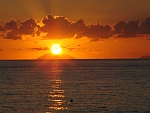 The most Northern of the isalnds and probaly the most picturesque with its ever active 926 metre high volcano. Glowing chunks of stone and lapilli are constantly spat out of its 3 craters. They light up the night and loudly roll down along the „Sciara del Fuoco", a unique spectacle, an impressive wall of black stone. Underwater it looks like a leap into darkness, a steep drop of black sand going down to a depth of 3000m, this is known as the „FOSSO DEL TIRRENO"
The most Northern of the isalnds and probaly the most picturesque with its ever active 926 metre high volcano. Glowing chunks of stone and lapilli are constantly spat out of its 3 craters. They light up the night and loudly roll down along the „Sciara del Fuoco", a unique spectacle, an impressive wall of black stone. Underwater it looks like a leap into darkness, a steep drop of black sand going down to a depth of 3000m, this is known as the „FOSSO DEL TIRRENO"
Stromboli brought its potential for destruction back to life when after ist last eruptions a tidal wave occured.....but there have always been volcanoes, a famous traveller such as Alexandre Dumas who experienced one of the frequent eruptions said" that was one of the remarkable nights of my life, I couldn't help but watch this formidable yet magnificent spectacle".
There are 2 landing places on the island, Ficogrande and Scari. In Cala di Ficogrande the jetty is reserved for the ferry, pleasure boaters can moor their boats at the other quay, but note that the water is rather shallow there and the pier has become quite damaged due to storm floods. In Scari, the end of the pier is reserved for ferries too but other landing places can be found at the other quay.
PANAREA
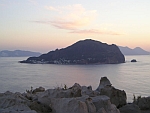 Panarea island, the smallest of the Lipari archipelago is surely most famous for its active nightlife and its international milieu. This island is marked by its elliptic shape and its high hills. The island‘s highest point is at 421 metres and is marked with a cross at its peak. The island's most important landing place is on the East coast of the island at half height near Punta Peppemaria in San Pietro and is called Scalo Ditella. This cement pier is 97 metres long and 10 metres wide and has a large number of bollards and rings for mooring. Within a distance of 200m around the pier it is prohibited to drop anchor so as not to hinder the passing of public transportation. Pleasure boaters can moor along the North side of the quay.The Cala Junco is a very special bay surrounded by high rock faces.
Panarea island, the smallest of the Lipari archipelago is surely most famous for its active nightlife and its international milieu. This island is marked by its elliptic shape and its high hills. The island‘s highest point is at 421 metres and is marked with a cross at its peak. The island's most important landing place is on the East coast of the island at half height near Punta Peppemaria in San Pietro and is called Scalo Ditella. This cement pier is 97 metres long and 10 metres wide and has a large number of bollards and rings for mooring. Within a distance of 200m around the pier it is prohibited to drop anchor so as not to hinder the passing of public transportation. Pleasure boaters can moor along the North side of the quay.The Cala Junco is a very special bay surrounded by high rock faces.
3rd day Panarea-Salina (Monday)
SALINA
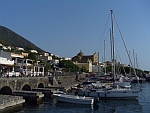 This is the 2nd largest island in regard to size and population, it also has the most luscious vegetation. Salina is well known for its capers and its vineyards where Malvasia grapes grow. Salina rules the archipelago with its mountainous core which was created by 2 volcanoes of yore: Monte delle Felci (962m)and Monte die Porci(860m). The island has a total of 4 landing places. Santa Marina is the island's most important harbour and has 2 landing places, it is easier to find space here and all necessary services are provided and fuel is available directly on the pier. The North quay is reserved for fishing boats and the South quay for guests.
This is the 2nd largest island in regard to size and population, it also has the most luscious vegetation. Salina is well known for its capers and its vineyards where Malvasia grapes grow. Salina rules the archipelago with its mountainous core which was created by 2 volcanoes of yore: Monte delle Felci (962m)and Monte die Porci(860m). The island has a total of 4 landing places. Santa Marina is the island's most important harbour and has 2 landing places, it is easier to find space here and all necessary services are provided and fuel is available directly on the pier. The North quay is reserved for fishing boats and the South quay for guests.
There is a landing place on the east side of the quaint fishing village of Rinella, the depth of the water is between 0.50m to 4m. Only small boats can be moored in Malfa and care must be taken because of the cliffs. In the part of town called Pollana the location of the film set from the film"Der Postmann"(„The Postman") can be visited. Salina island (also called „twins"island because of its twin peaks)has 2300 inhabitants who are divided into 3 communities is very popular with visitors in summer. one of the sights to see is the Museo della Emigrazione(Museum of Emigration) It stands as a remminder of the emigration of the Lipari people to various other continents in the 19th and 20th centuries.
• An excursion to Leni and to the village of Pollara, situated in the middle of a crater, is available.
• Swimming in the salty waters of Lingua where the most famous „Granita" of the Aeolian islands can be enjoyed.
• Overnight stay
4th day Salina-Filicudi-Salina (Tuesday)
FILICUDI
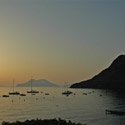 This is an island for real water babies. In ancient times it was called „Phoenicusa" which means as good as „rich in fern" it is also the oldest of the Aeolian islands. Wild and untouched, it is the pride of its 250 inhabitants who live here in 3 townships. From Capo Graziano, a highly interesting archaeological area, a path can be followed from the Bay of Porto to Montagnola di Capo Graziano where an archaeological excavation site from the Bronze age is situated. It is made up from about 30 oval huts built on a terrace. Down in the depths below lie the remains of 2 Roman ships, unfortunately they were looted of all their treasures and today diving there is prohibited.
This is an island for real water babies. In ancient times it was called „Phoenicusa" which means as good as „rich in fern" it is also the oldest of the Aeolian islands. Wild and untouched, it is the pride of its 250 inhabitants who live here in 3 townships. From Capo Graziano, a highly interesting archaeological area, a path can be followed from the Bay of Porto to Montagnola di Capo Graziano where an archaeological excavation site from the Bronze age is situated. It is made up from about 30 oval huts built on a terrace. Down in the depths below lie the remains of 2 Roman ships, unfortunately they were looted of all their treasures and today diving there is prohibited.
• Swimming and snorkelling in „La Canna" di Filicudi, sightseeing at Grotta del Bue Marino (Grotto of the sea cow)
• Sailing round the island from Capo Graziano to Pecorini, past the cliffs of Montenasseri
• Lunch in the bay (Pecorini)
• Overnight stay in the bay of Salina (Lingua)
SALINA
This is the 2nd largest island in regard to size and population, it also has the most luscious vegetation. Salina is well known for its capers and its vineyards where Malvasia grapes grow. Salina rules the archipelago with its mountainous core which was created by 2 volcanoes of yore: Monte delle Felci (962m)and Monte die Porci(860m). The island has a total of 4 landing places. Santa Marina is the island's most important harbour and has 2 landing places, it is easier to find space here and all necessary services are provided and fuel is available directly on the pier. The North quay is reserved for fishing boats and the South quay for guests.
There is a landing place on the east side of the quaint fishing village of Rinella, the depth of the water is between 0.50m to 4m. Only small boats can be moored in Malfa and care must be taken because of the cliffs. In the part of town called Pollana the location of the film set from the film"Der Postmann"(„The Postman") can be visited. Salina island (also called „twins"island because of its twin peaks)has 2300 inhabitants who are divided into 3 communities is very popular with visitors in summer. one of the sights to see is the Museo della Emigrazione(Museum of Emigration) It stands as a remminder of the emigration of the Lipari people to various other continents in the 19th and 20th centuries.
5th day - Salina-Lipari (Wednesday)
• Possibility of viewing the palace and the Archaeological museum(most important in Europe). Swimming in the turquoise sea at the pumice stone quarry in the bay of Porticello..
• Tour of the island from Sottomonastero to Canneto
LIPARI (The most important of the Aeolian Islands)
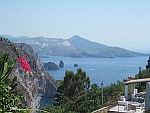 Lipari island is the largest of the Aeolian islands and is easily recognised by the massive profile of Monte Chirica (602m) and Monte S. Angelo (593m). Monte Pelato is known worldwide for the fact that it is totally covered with pumice which is mined here and exported all over the world. The island has a lot of townships, Lipari, the most important, streches between the bays of Marina Lunga and Marina Corta and is split into 2 by the Acropolis which was mounted there in the 15th century. One should definitely pay the Museo Eoliano a visit, 25 rooms hold detailed documentation of the cultures which came to be on the island over the centuries.
Lipari island is the largest of the Aeolian islands and is easily recognised by the massive profile of Monte Chirica (602m) and Monte S. Angelo (593m). Monte Pelato is known worldwide for the fact that it is totally covered with pumice which is mined here and exported all over the world. The island has a lot of townships, Lipari, the most important, streches between the bays of Marina Lunga and Marina Corta and is split into 2 by the Acropolis which was mounted there in the 15th century. One should definitely pay the Museo Eoliano a visit, 25 rooms hold detailed documentation of the cultures which came to be on the island over the centuries.
There is no real harbour here but various townships have acceptable landing places. The most imporatant of which being: Marina Corta with 2 docks opposite each other :but only a small part of the south east jetty is reserved for pleasure boats. The harbour at Sottomonastero is to the north of Marina Corta and begins at Punta Scaliddi. It has various quays and a 65 m long jetty for pleasure boats which guarantees about 50 places for boats and protection from the wind.
The harbour at Pignataro has an outer pier at a depth of 3 to 5 metres where pleasure boats can be moored too. It offers the best protection against the wind. Canneto is equipped with a pier which ferries land at and is protected from the wind. While sailing round the island we will see the small harbour of Pietralunga and we will sail by Inzolfato, a stretch of coastline with a very structured composition of geological layers of a sulphureous nature. We will reach the cliffs of Pietra Menalda and Pietra Lunga which watch over the channel that seperates Lipari from Vulcano. From here we will go on to Rocco di Lipari and on to Marina Corta.
6th day Lipari-Vulcano-Panarea (Thursday)
• Tour of Vulcano island, mud baths and swimming in the fumaroles of Sabbie Nere, sightseeing at „Grotto del Cavallo"
• Possible excursion to „Fossa della Fucina"
VULCANO
 Only an 800m wide channel seperates Lipari from Vulcano island and its cliffs. This island formerly known as Hiera (Holy one) is divided into 3 areas. Vulcano Piano at about 400m with lush vegetation mostly consisting of gorse bushes; then Porto Vulcano, the flat part of the island where ships can dock and which is overlooked by a crater which was formed during its last eruption between 1888 and 1890; than last of all Vulcanello which is connected to the rest of the island by an isthmus, Vulcanello emerged from the sea during an eruption in 183 BC and was a seperate islet, the isthmus connecting Vulcanello to the rest fo the island was created during the last eruption. With its fine sandy beaches and its rock formations, its sulphureous lakes and frothing waters the island really does offer unique landscape. The Greeks called the island „Fire Island" where the gods used to produce their weapons for heroes.
Only an 800m wide channel seperates Lipari from Vulcano island and its cliffs. This island formerly known as Hiera (Holy one) is divided into 3 areas. Vulcano Piano at about 400m with lush vegetation mostly consisting of gorse bushes; then Porto Vulcano, the flat part of the island where ships can dock and which is overlooked by a crater which was formed during its last eruption between 1888 and 1890; than last of all Vulcanello which is connected to the rest of the island by an isthmus, Vulcanello emerged from the sea during an eruption in 183 BC and was a seperate islet, the isthmus connecting Vulcanello to the rest fo the island was created during the last eruption. With its fine sandy beaches and its rock formations, its sulphureous lakes and frothing waters the island really does offer unique landscape. The Greeks called the island „Fire Island" where the gods used to produce their weapons for heroes.
Pleasure boaters are allowed to use the pier at Gelso along side liner traffic,hydrofoil boats and cargo boats, Gelso is between Punta die Porci and Punta Bandiera. The pier there is 30m long and 11m wide and should serve as a point of evacuation in case of a volcanic eruption.
The sailing tour around the island starts in Porto di Levante and soon reaches the Grotta del Cavallo, inside this grotto rays of sunshine give off special light and colour effects. Then we move on to the lighthouse and by the township of Gelso a very fine sandy beach can be visited. This coastline is covered with bays of unique beauty, all the way back to Porto di Levante.
7th day Panarea-Tropea (Friday)

• Chance to visit Cala Milazzese with its „prehistoric settlement"
• Sailing tour around the island, to the cliffs of Panarea, set off for Tropea at 5 pm.
Arrival in Tropea during the evening after about a 4 hour crossing.
8th day Tropea (Samstag)
On Saturday morning after breakfast we disembark.
These special sailing trips can be booked without a language course on request.
ask about dates and prices

